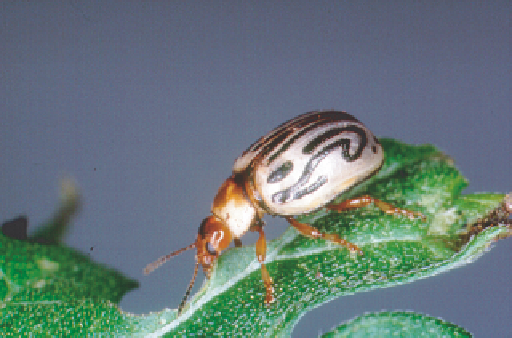Biology Reference
In-Depth Information
symptoms on parthenium (McFadyen 1992), and the impact on plant height, leaf
production, flower production and plant biomass becomes significant when the gall
damage is initiated at early stages of plant growth (Dhileepan 2001, 2003b, 2004;
Dhileepan and McFadyen 1997, 2001; Navie et al. 1998b). Grass competition sig-
nificantly increased the effectiveness of the parthenium stem-galling moth
E. strenuana
(Navie et al. 1998b).
The leaf-feeding beetle
Zygogramma bicolorata
Pallister (Fig. 12.4) was intro-
duced from Mexico into Australia in 1980 (McFadyen and McClay 1981). Evidence
of
Z. bicolorata
activity on parthenium in Australia was first noticed in 1990
(Dhileepan and McFadyen 1997). Since then, due to both natural spread by the
beetle and deliberate spread efforts by farmers, the area with
Z. bicolorata
defolia-
tion has increased to around 12,000 km
2
, in central Queensland (Dhileepan et al.
2000). Adult beetles can live up to 2 years and usually spend around 6 months dia-
pausing in the soil during autumn and winter (McFadyen 1992). In central
Queensland the leaf-feeding beetle
Z. bicolorata
caused 91-100% defoliation,
resulting in reductions in weed density by 32-93%, plant height by 18-65%, plant
biomass by 55-89%, flower production by 75-100%, soil seed bank by 13-86%
and seedling emergence by 73-90% (Dhileepan et al. 2000).
The stem-boring weevil
Listronotus setosipennis
(Hustache) (Coleoptera:
Curculionidae) (Fig. 12.5) was introduced into Australia from northern Argentina
and southern Brazil there during 1982-1986 (McFadyen 1985; Wild et al. 1992)
after host specificity tests had been conducted in Brazil (Wild 1980) and Australia
(Wild et al. 1992).
L. setosipennis
became established in 1983 soon after the first
release (Wild et al. 1992) but its field incidence remained low and sporadic
(McFadyen 1992; Dhileepan et al. 1996; Dhileepan and McFadyen 1997; Dhileepan
2003a). Adult feeding and oviposition damage is negligible. Larval feeding has the
ability to kill or prevent further development of parthenium seedlings (Wild et al.
1992). Incidence of
L. setosipennis
was recorded in 48% of the parthenium-infested
Fig. 12.4
Zygogramma bicolorata
adult

